Blue whales and whale sharks are gigantic ocean creatures, yet they have significant differences.
Blue whales are mammals, breathe air, and are carnivorous. On the other hand, whale sharks are the largest fish species, breathe through gills, and are filter feeders. Additionally, Blue Whales are considerably larger and faster. Contrarily, Whale Sharks have unique, checkerboard-patterned skin and an adapted mouth for suction feeding.
These two marine giants, often mistaken for one, are far from identical.
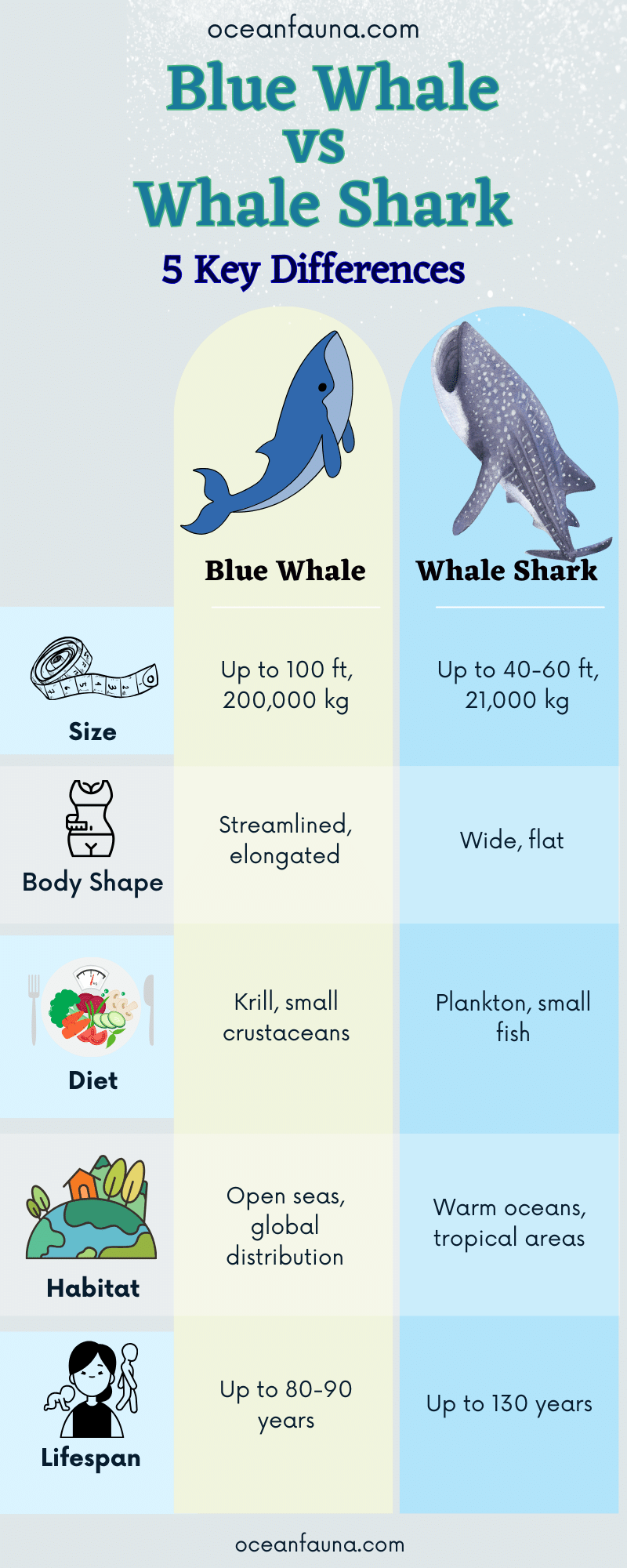
Did you know? The blue whale calf drinks up to 380 liters of milk daily from its mother. But the whale shark eggs develop and hatch within the mother, who gives birth to live young!
But there’s a lot more! Keep reading to dive deeper into the intriguing differences between Blue Whales and Whale Sharks. We promise you’ll learn something new about these ocean giants.
Blue Whale vs Whale Shark – A Quick Comparison
| Feature | Blue Whale | Whale Shark |
| Scientific Name | Balaenoptera musculus | Rhincodon typus |
| Family | Balaenopteridae | Rhincodontidae |
| Body Shape | Streamlined, elongated | Wide, flat |
| Size | Up to 100 ft, 200,000 kg | Up to 40-60 ft, 21,000 kg |
| Diet | Krill, small crustaceans | Plankton, small fish |
| Habitat | Open seas, global distribution | Warm oceans, tropical areas |
| Social Behavior | Solitary, occasionally in small groups | Solitary, occasionally in feeding aggregations |
| Lifespan | Up to 80-90 years | Up to 130 years |
| Gestation Period | 10-12 months | Unknown, estimated to be over a year |
| IUCN Status | Endangered | Endangered |
Blue Whale vs Whale Shark – What Are the Key Differences?
Blue whales and whale sharks are two of the largest creatures in the sea. They are both enormous, gentle giants that filter-feed, sifting their food from the ocean water. Yet, these two underwater marvels are different. So, let’s dive in and explore these differences.
1. Taxonomy and Scientific Classification
One of the most significant differences between the blue whale and whale shark lies in their taxonomy and classification.
Blue Whale
Blue Whale is a mammal (Mammalia). It is scientifically known as Balaenoptera musculus and is the largest animal ever to have lived on Earth, including all dinosaurs.
It belongs to the infraorder Cetacea, which comprises all the whale species, and it’s part of the family Balaenopteridae, also known as the Rorqual family. This family includes other large species, such as humpback and fin whales.
Five recognized sub-species of the blue whale found across the globe include
- The Northern blue whale, B. m. musculus.
- The Antarctic blue whale, B. m. intermedia.
- The Northern Indian Ocean blue whale, B. m. indica.
- The Pygmy blue whale, B. m. brevicauda.
- The Chilean blue whale
Whale Shark
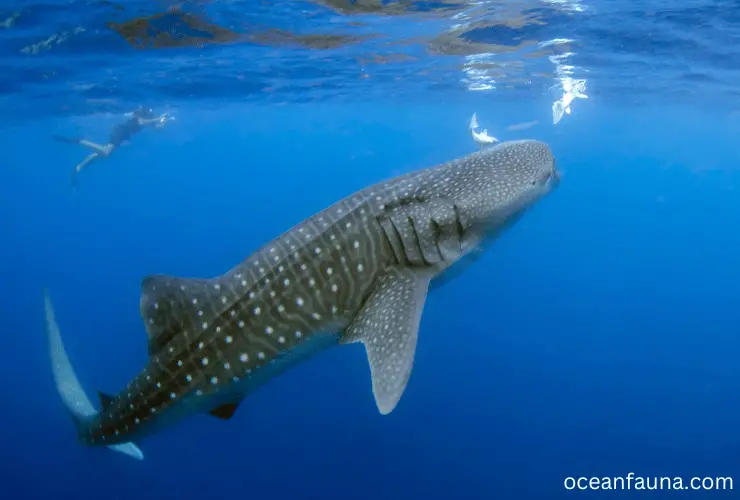
On the other side, the Whale Shark is a fish (Chondrichthyes). It is scientifically known as Rhincodon typus and is the world’s largest fish.
In spite of its name, the Whale Shark isn’t a whale but a shark species. It is classified in the order Orectolobiformes and the family Rhincodontidae. There are no recognized subspecies of Whale sharks.
| Classification | Blue Whale | Whale Shark |
| Kingdom | Animalia | Animalia |
| Phylum | Chordata | Chordata |
| Class | Mammalia | Chondrichthyes |
| Order | Artiodactyla | Orectolobiformes |
| Family | Balaenopteridae | Rhincodontidae |
| Genus | Balaenoptera | Rhincodon |
| Species | B. musculus | R. typus |
2. Habitat and Distribution
Despite both being marine creatures, Blue Whales and Whale Sharks have distinct preferences and ranges when it comes to their habitats.
Blue Whale
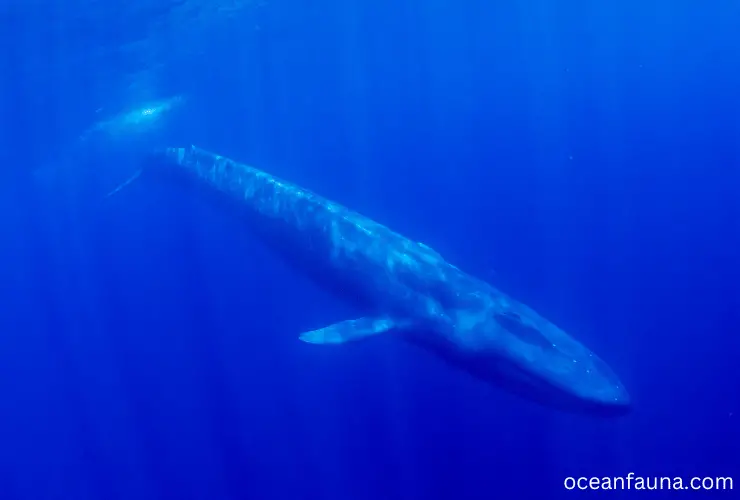
Blue Whales are truly cosmopolitan creatures. They are found in all of the world’s oceans, except the Arctic, and travel great distances depending on the season.
Sightings are also extremely rare in specific regional waters like the Mediterranean, Okhotsk, or Bering seas and along the eastern coasts of South America and Australia.
Also Read: Blue Whale Vs Orca: Key Differences & Battle Winner
During summer, they’re typically found in polar waters. As winter arrives, the ice expands, and the whales migrate to warmer, tropical waters. This is also where they breed and give birth to their calves. Their exact distribution can vary yearly, depending on food availability, as detailed by National Oceanic and Atmospheric Administration.
Whale Shark
Like the Blue Whale, the Whale Shark is also a migratory species but tends to stick closer to the equator. These sharks are typically found in warm, tropical oceans. They are often seen off the coasts of countries like Australia, Mexico, and the Philippines.
They are also seen in many other parts, such as
- India,
- Galapagos Islands
- Indonesia.
- Maldives
- South Africa
- Belize
- Southeast Asia
Whale Sharks prefer warmer waters and congregate in certain areas where food is plentiful. Unlike the Blue Whale, they don’t generally venture into cold polar waters. ~Source
| Habitat Aspect | Blue Whale | Whale Shark |
| Oceanic Range | All except the Arctic | Mostly tropical |
| Preferred Waters | Polar in summer (for feeding), tropical in winter (for breeding) | Warm, tropical |
| Migration Pattern | Long-distance, polar to tropical | Mostly within tropical regions |
3. Physical Appearance
Although both the Blue Whale and the Whale Shark are large marine animals, their physical appearances clearly differ.
Blue Whale
- Coloration: As their name implies, Blue Whales have a blue-grey coloration that appears more bluish underwater and greyish when they surface. Their underbelly takes on a lighter hue, often with some grey or white spots.
- Body Size: They have an average length ranging from 70 to 90 feet, and some individuals reach up to 100 feet. It can weigh as much as 200 tons.
- Body Shape: Blue Whales have long, slender body that is hydrodynamic, perfect for their long migration routes.
- Skin: Their skin is smooth.
- Fins: Unlike most other whale species, they have very small dorsal fins relative to their body size.
- Head: The head of a Blue Whale makes up about one-third of its total body length and is U-shaped when viewed from above.
- Baleen plates: Baleen plates can be up to 1 meter long.
Whale Shark
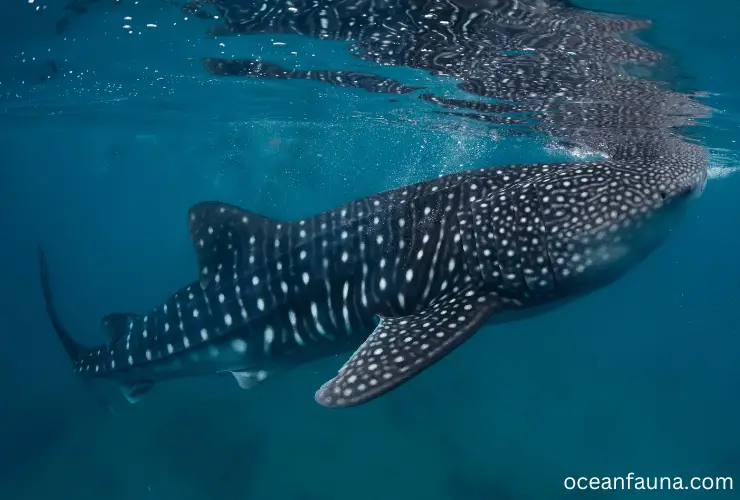
- Body Size: Whale Sharks reach lengths of up to 40 feet on average, with some recorded as long as 60 feet. They weigh around 21,000 kg on average.
- Body Shape: They have a wide and robust body.
- Head: The Whale Shark is immediately recognizable due to its broad, square head and wide mouth, which can be up to 1.5 meters wide.
- Coloration: It’s also known for its unique pattern of white spots and stripes on dark grey skin, which are unique to each individual, much like human fingerprints.
- Fins: Unlike the Blue Whale, the Whale Shark has a pair of large dorsal fins and pectoral fins.
- Skin: Its skin is thick and rough, unlike the smooth skin of the Blue Whale.
| Physical Aspect | Blue Whale | Whale Shark |
| Average Length | 70-90 feet (up to 100 feet) | 40 feet (up to 62 feet) |
| Weight | Up to 200 tons | Around 20.6 tons |
| Body Shape | Long and slender | Wide and robust |
| Skin Color | Blue-grey with lighter underbelly | Dark grey with white spots and stripes |
| Skin Texture | Smooth | Thick and rough |
| Head Shape | U-shaped | Broad, square |
| Dorsal Fin | Small | Large |
| Mouth | Small relative to body size | Wide, can be up to 1.5 meters wide |
4. Diet and Feeding Habits
Even though both the Blue Whale and the Whale Shark are filter feeders, their feeding habits and diets show marked differences.
Blue Whale
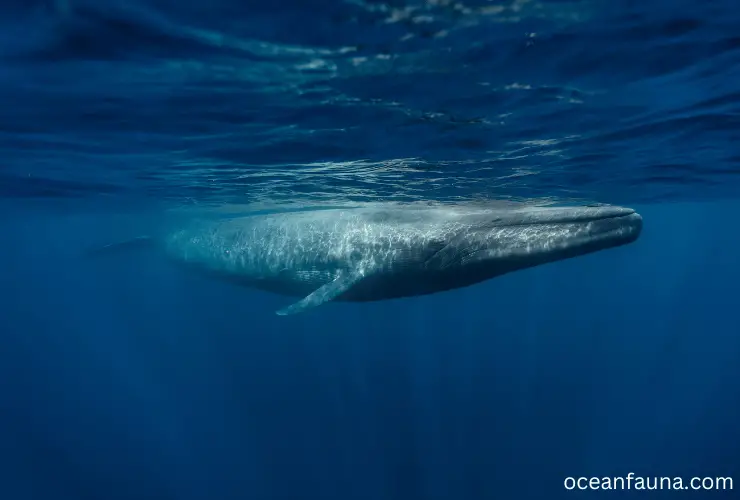
The Blue Whale feeds almost exclusively on tiny shrimp-like animals called krill. During feeding seasons in the polar regions, a single individual consumes about 4 tons of krill daily, as documented by the American Cetacean Society.
Blue Whales are baleen whales. It means they’ve got a series of baleen plates instead of teeth in their mouths. These plates act like a sieve.
The whale takes a large gulp of water full of krill, then shuts its mouth and forces the water out through the baleen plates, trapping the krill inward to be swallowed. This feeding method is known as filter feeding and is a common strategy among several large marine animals.
Whale Shark
The Whale Shark’s diet is slightly more varied than the Blue Whale. They eat a mix of plankton (microscopic plants and animals), small fish, squid, krill, jellyfish, and crab larvae. ~Source
Like the Blue Whale, the Whale Shark takes in a large mouthful of water and then closes its mouth, pushing the water out through its gills.
But instead of baleen, the Whale Shark has around 3,000 tiny teeth (about the size of match heads) on its gills which work like a filter, trapping food particles as the water is expelled.
Whale Sharks are known for their unique feeding behavior known as “vertical feeding.” They position themselves vertically in the water, with their heads at the surface and their tails pointing down, opening and closing their mouths to suction in water and plankton, according to a research article by the University of Hertfordshire.
| Diet and Feeding Habits | Blue Whale | Whale Shark |
| Diet | Primarily krill | Plankton, small fish, squid, crab larvae, krill. |
| Feeding Method | Baleen filter feeding | Gill raker filter feeding |
| Notable Feeding Behavior | – | Vertical feeding |
5. Social Behavior
While both the Blue Whale and the Whale Shark are primarily solitary animals, their social behaviors exhibit interesting differences.
Blue Whale
Blue Whales are generally considered solitary creatures. They are most often seen alone or in pairs. However, they can occasionally be seen in small groups in areas with high food concentrations. The bond between mother and calf is strong.
Blue Whales communicate with low-frequency sounds, which can travel long distances underwater. These sounds are thought to serve numerous purposes, such as navigation, finding food, and mates.
Whale Shark
Whale Sharks are also solitary creatures for the most part, typically seen alone or in small groups.
However, they are known to gather in large numbers in areas with abundant food supplies. These aggregations can sometimes include hundreds of Whale Sharks, and they are often associated with seasonal events like coral spawning or fish spawning, which provide a rich food source.
While Whale Sharks are not known to be highly social animals, these feeding aggregations suggest that they do tolerate each other’s presence when there’s enough food to go around. They rely on echolocation to communicate with each other. ~Source
| Social Behavior | Blue Whale | Whale Shark |
| Typical Group Size | Alone or in pairs | Alone or groups |
| Communication | Low-frequency sounds | Echolocation |
| Aggregations | Rare, associated with food availability | Common, associated with food availability |
| Mating | Mating in winter, calf every 2-3 years | Mating not often observed; live young |
6. Reproduction and Lifecycle
The reproductive cycles and lifecycles of Blue Whales and Whale Sharks reflect the different survival strategies of mammals and fish.
Blue Whale
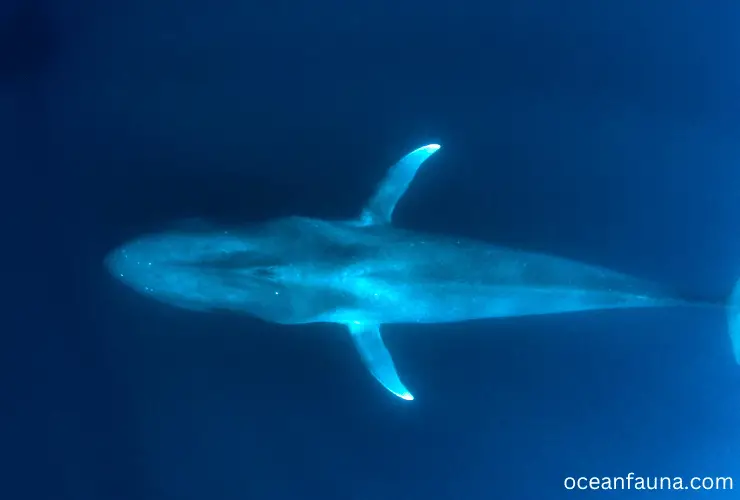
- Sexual Maturity: Blue Whales become sexually mature between the ages of 5 to 15 years.
- Mating season: Their mating season is typically during the winter months.
- Gestation period: Following a gestation period of about 10-12 months, a female Blue Whale delivers a single calf. This calf can be up to 8 meters long at birth, making it one of the largest babies in the animal kingdom.
- Calves: The calf will nurse on its mother’s milk for 6 to 7 months until it’s weaned. The milk is extremely rich in fat (about 50% fat content), which helps the calf grow rapidly – gaining about 90 kg per day in the early months.
- After weaning, the calf may stay with the mother for about a year before becoming self-reliant.
- Lifespan: The typical lifespan of a Blue Whale is evaluated to be approximately 80-90 years. Although there are records of individuals living over 100 years, as documented by Subhrajit Chakraborty.
Whale Shark
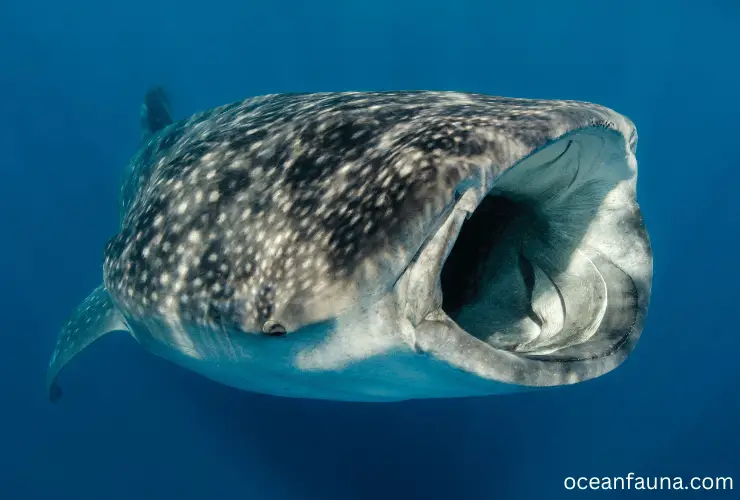
Sexual Maturity: Whale Sharks reach sexual maturity later than Blue Whales, at around 25 to 30.
Their reproduction is ovoviviparous, meaning the female retains the eggs inside her body and gives birth to live young.
It’s estimated that a female Whale Shark can carry hundreds of eggs at a time, giving birth to at least 16 pups. The largest documented pup litter was 300 juveniles at one time.
Calves: Whale Shark babies are almost 2 ft long at birth and are largely left to fend for themselves. The reproductive habits of Whale Sharks are still a mystery to scientists, as births have never been observed in the wild.
Lifespan: The lifespan of a Whale Shark is considered to be around 80 to 130 years, which is lengthier than blue whales ~Source
| Reproduction | Blue Whale | Whale Shark |
| Sexual Maturity | 5-15 years | Around 25 years |
| Mating Season | Winter | Not well understood |
| Gestation Period | 10-12 months | Not well-understood |
| Offspring at Birth | Single calf, 8 meters long | Multiple pups, 60 cm long |
| Weaning Period | 6-7 months | N/A |
| Lifespan | 80-90 years (up to 100) | 80–130 years |
7. Natural Predators
The Blue Whale and Whale Shark are among the largest creatures in the ocean, so they have a few natural predators.
Blue Whale
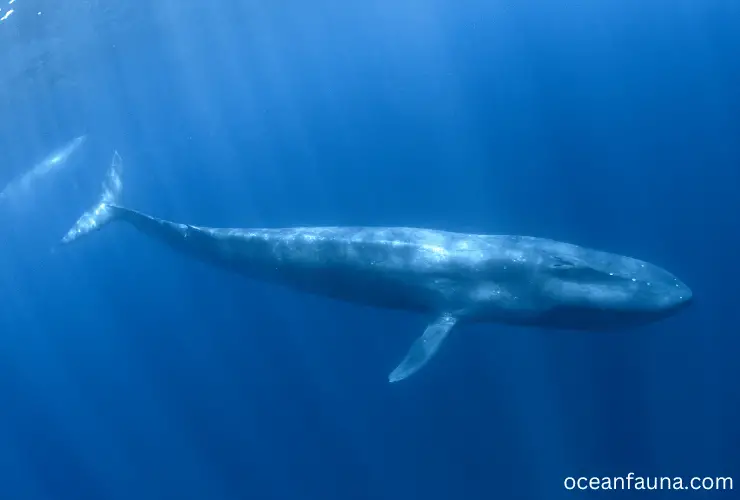
Blue whales face primary risk from Killer Whales (orcas), which are known to attack Blue Whale calves and, in some rare instances, adult individuals. However, these attacks are relatively uncommon.
Whale Shark
Like Blue Whales, adult Whale Sharks also have few natural predators due to their size. Potential predators could include larger shark species, blue marlin, blue sharks, and killer whales, which feed on younger or weaker individuals. However, reports of predation on Whale Sharks are rare.
| Natural Predators | Blue Whale | Whale Shark |
| Ocean Predators | Killer Whales (rarely) | Larger sharks, Killer Whales (rarely) |
| Human Threats | Historical whaling, ship strikes, entanglement in fishing gear | Hunting for meat, fins, and oil, bycatch, boat strikes |
8. Defense Mechanism
Both the Blue Whale and the Whale Shark rely primarily on their size and the ability to dive deep or swim away quickly as their main defensive strategies.
Blue Whale
Blue Whales do not have aggressive defense mechanisms like some other marine creatures. In fact, their primary defense is their size.
Most potential predators are simply too small to threaten a healthy, full-grown Blue Whale seriously. If threatened, Blue Whales can use their powerful tails to create a strong force in the water, potentially deterring a predator.
Moreover, they can also dive deep and swim at high speeds (up to 20-35 mph) to evade potential threats.
Whale Shark

Like Blue Whales, Whale Sharks also rely on their size as a primary defense against potential predators. Their thick skin, up to 6 inches in some places, provides some measure of protection against any attack.
In addition, Whale Sharks can also dive deep when threatened, disappearing quickly from the sight of potential threats. But their main reaction when threatened is usually to simply swim away. They are gentle creatures and do not display aggressive behaviors.
| Defense Mechanism | Blue Whale | Whale Shark |
| Primary Defense | Size, powerful tail, speed, deep diving | Size, thick skin, deep diving, swimming away |
| Aggressive Behavior | Rare | Rare |
9. Interaction With Humans
Blue whales and Whale sharks interact with humans differently.
Blue Whale
Blue Whales generally do not have a lot of direct interaction with humans due to their preference for deeper waters and their elusive nature. However, they are a major draw for whale-watching tours, especially in areas where they are known to feed or breed.
Whale Shark
Whale Sharks have a bit more direct interaction with humans compared to Blue Whales. They are a popular draw for ecotourism, with snorkelers and divers often seeking the opportunity to swim alongside these gentle giants. This has become a major industry in some areas, like the Philippines and the Maldives.
| Species | Tourism Interaction |
| Blue Whale | Whale watching |
| Whale Shark | Swimming and diving alongside |
10. Threats and Conservation Status
Both Blue Whales and Whale Sharks are endangered species that face significant threats from human activities.
Blue Whale
Blue Whales are currently listed as “Endangered” on the IUCN Red List.
The primary threats to Blue Whales come from human activities. Historically, Blue Whales were hunted extensively for their blubber and meat, pushing them to the brink of extinction. Other threats include
- Ship strikes
- Entanglement in fishing gear,
- Noise pollution.
Commercial whaling had also been a major threat to Blue Whales, which led to a dramatic decline in their numbers. Since the ban on commercial whaling in 1966, Blue Whale populations have shown signs of slow recovery. Still, they remain far from their pre-whaling numbers.
Whale Shark
Whale Sharks are documented as “Endangered” on the IUCN Red List. Like Blue Whales, Whale Sharks also face threats from human activities. These include
- Targeted hunting for their meat, fins, and oil
- Accidental catch in fishing operations.
- Boat strikes
- Disturbance from ecotourism activities. ~Source
| Aspect | Blue Whale | Whale Shark |
| IUCN Status | Endangered | Endangered |
| Historic Threats | Commercial whaling | Hunting for meat, fins, and oil |
| Current Human Threats | Ship strikes, entanglement, noise pollution | Hunting, bycatch, potential disturbance from tourism |
11. Blue Whale vs Whale Shark: Who Would Win the Battle?
The blue whale is much larger and heavier than the whale shark. It could potentially cause significant damage with a single powerful movement of its tail or body.
Moreover, blue whales are faster swimmers than other marine animals. They can reach speeds of up to 20 mph when they’re alarmed. In contrast, whale sharks are not built for speed and typically swim at speeds of around 3 mph.
Whale Sharks surely have thousands of tiny teeth. However, they are filter feeders, so they use their teeth not for biting or tearing flesh but for filtering plankton from the water.
So, if these two gentle giants were to fight, which is highly unlikely due to their peaceful and non-aggressive behaviors, the Blue Whale, with its superior size, strength, and speed, would probably have the advantage.
Wrapping Up
So, are Blue Whales and Whale Sharks the same? Definitely not! Despite both being gentle giants of the ocean with similar filter-feeding habits, they are entirely different creatures.
Blue Whales are marine mammals, astoundingly large and fast, while Whale Sharks, the largest fish, showcase a unique pattern on their skin and a different feeding method.
Their habitats, behaviors, and lifestyles have been shaped differently by evolution. As we delve deeper into understanding these fascinating marine dwellers, it becomes clear that every species has its unique spot in the marine world.
We sure hope you’ve had a fun time learning with us today! Pop back anytime for more fascinating creature comparisons. Catch you next time!


4 thoughts on “Blue Whale vs Whale Shark: Differences and Battle Winner”